Natural learning path Grotzli Walk
The Grotzli Trail offers a nature-based learning experience focused on geology, wildlife and alpine flora. You will be amazed by the wonders of nature as you follow the circular trail. Leisure and relaxation go hand in hand with the opportunity to discover more about the fascinating nature. The hike starts and ends at the Fürenalp mountain station /restaurant. The wild music of mountain streams combined with the beautiful scenery fills you with energy – individual places of power along the path invite you to pause for a moment. The "Bear's Nest" exhibition shows the exciting discovery of the finds of brown bear bones that are over 12,400 and 9,500 years old.
Information
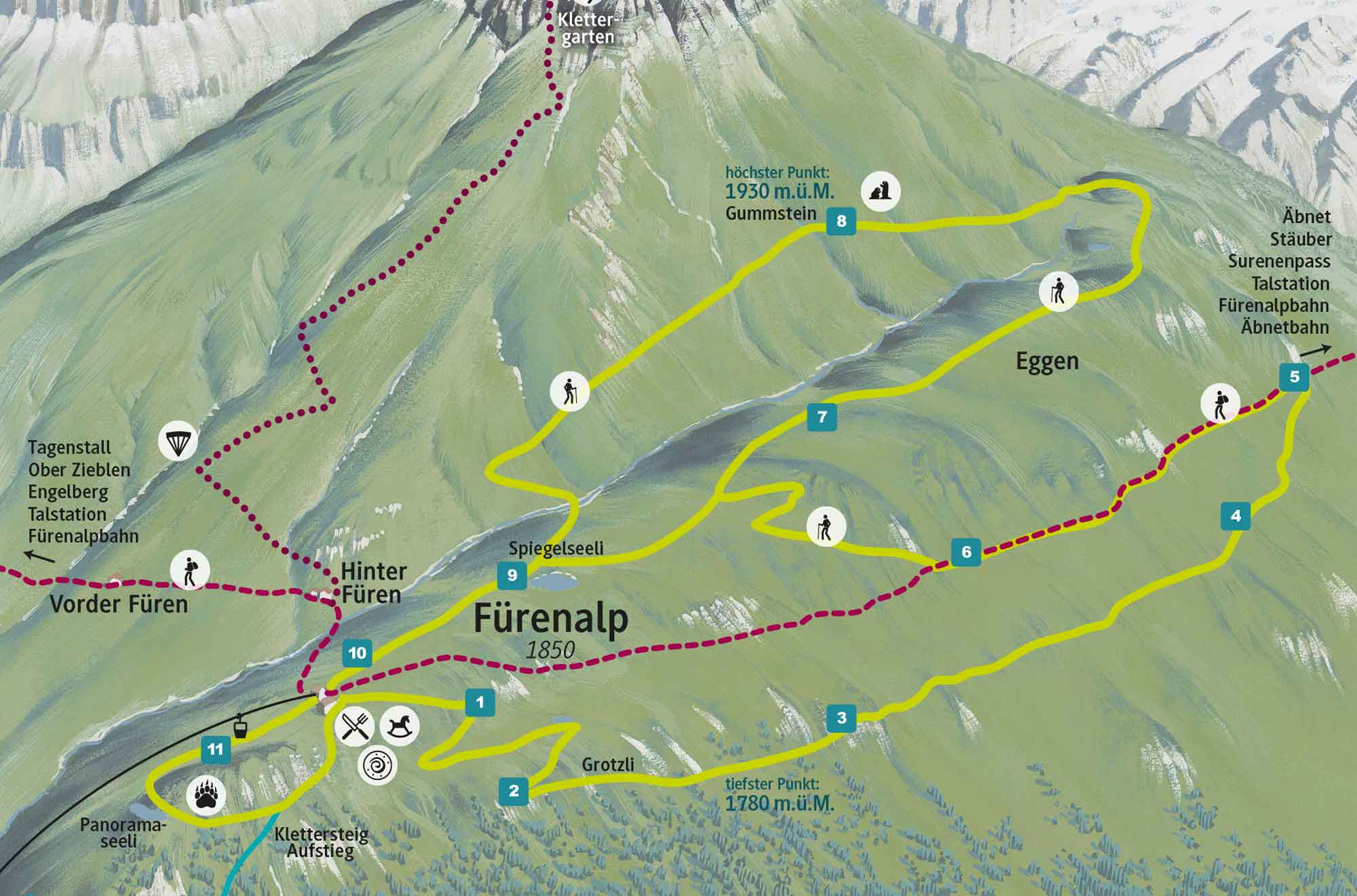
| Start/ End | Restaurant Fürenalp | |
| round trip | 3.4 km | |
| Altitude difference | 150 hm | |
| Duration | ca. 1.5 hours | |
| Section (Upper /Lower) | ca 45 minutes |
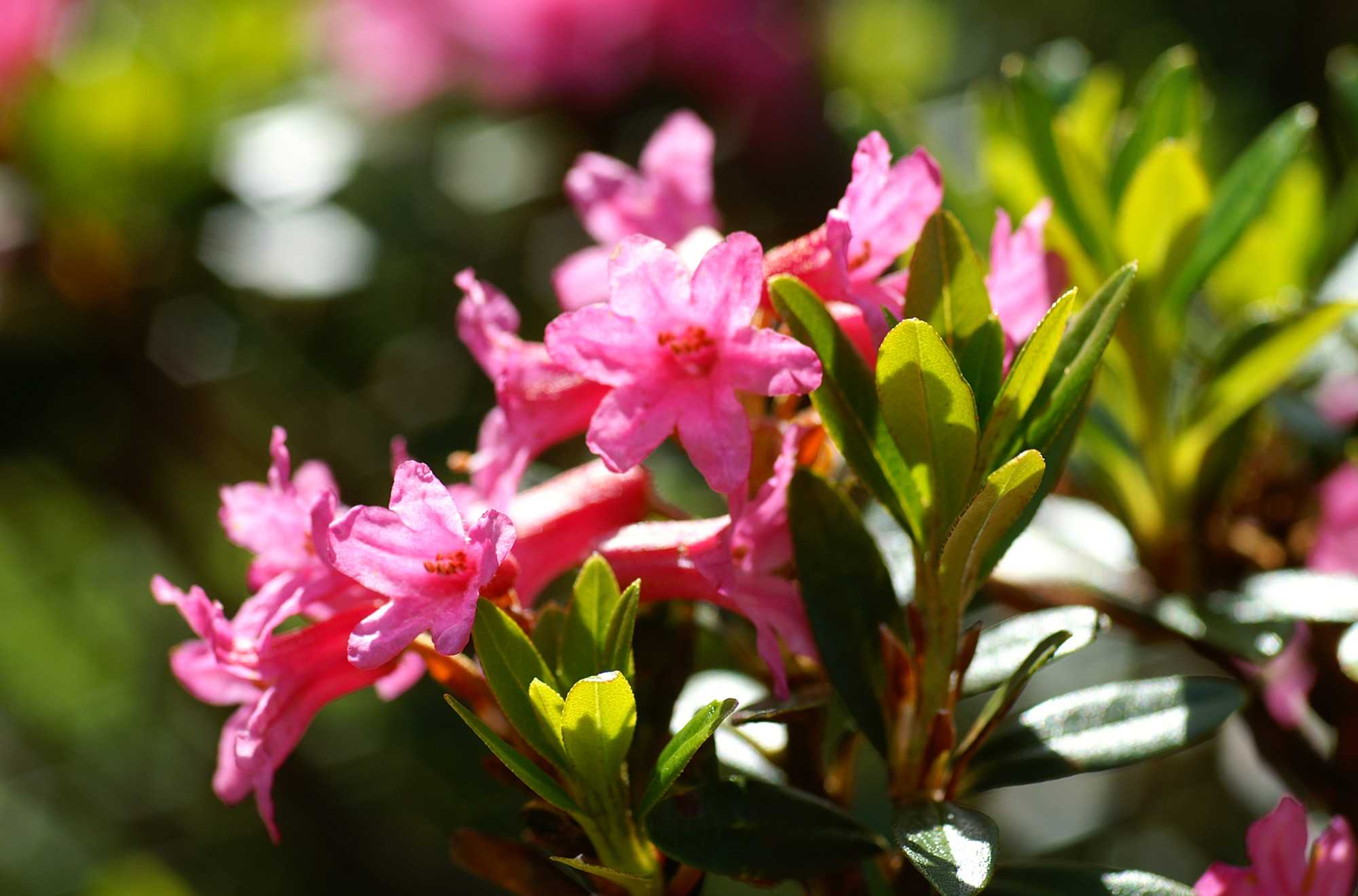
1 Floral splendour
Fürenalp – A paradise for flora fanatics
From spring to autumn, Fürenalp showcases an extraordinary diversity of plant life (with over 700 species).
Particularly striking is the mountain springtime. This floral richness thrives on nutrient-poor soils, known as dry or lean habitats, which change in composition within a few meters. Many areas are officially listed as dry zones of regional ecological importance.
For more detailed information, consult alpine flower or herbal guides.
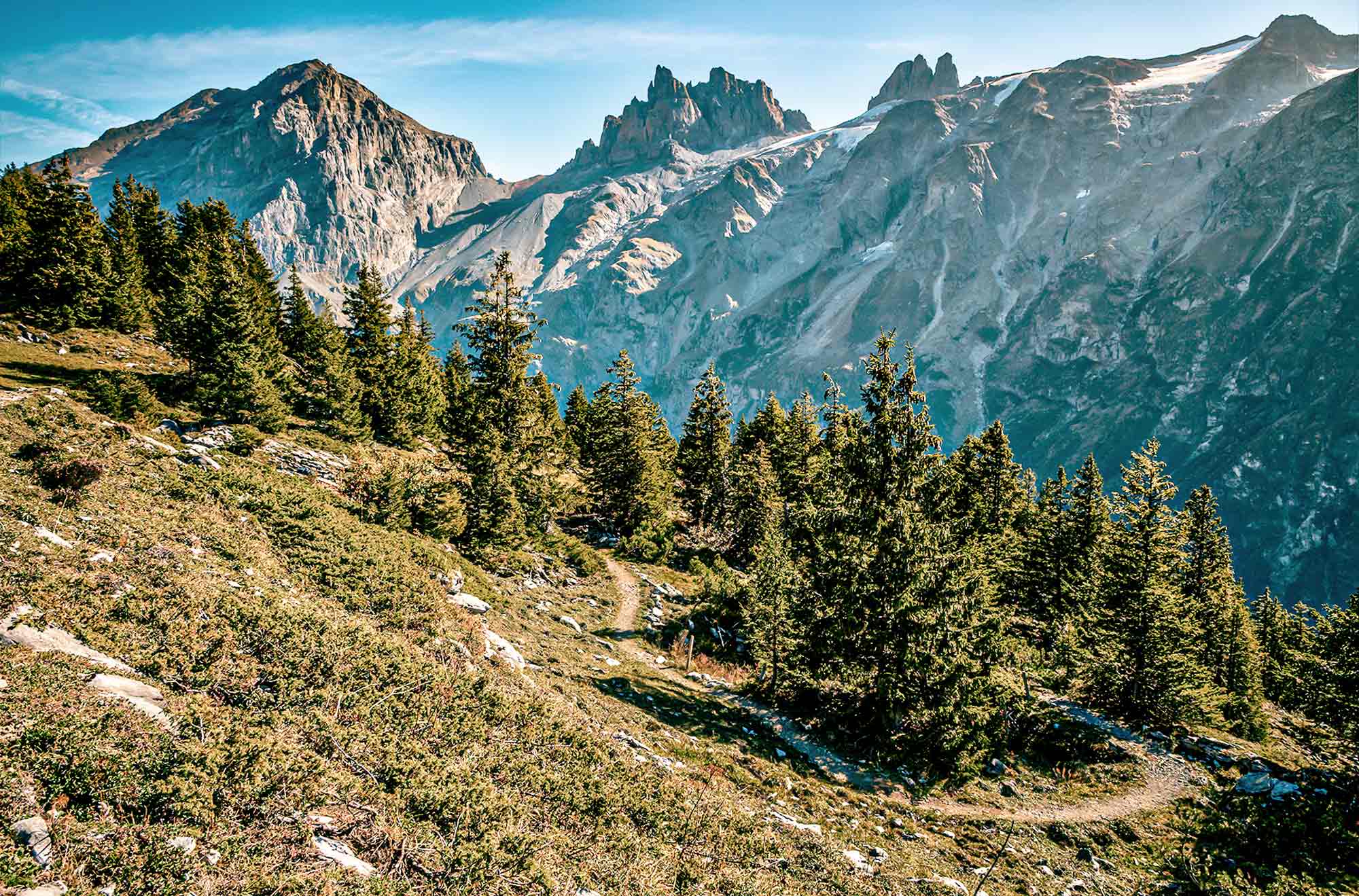
2 Mountain Forest
Nature’s hidden gems: The role of young spruces "Grotzli" in alpine forest ecology
«Grotzli» are not strange, eerie figures, but in the Engelberg dialect “Grotzli” is the name for young trees, in particular small spruces. These resilient trees grow slowly, sometimes taking over 30 years to reach a height of just half a meter. Often centuries old, they remain small due to the harsh alpine conditions. Growing tightly in clusters called “Rotten= mobs” they protect each other from wind, snow, and cold. The forest plays a vital role in preventing natural hazards like avalanches and landslides, and it supports a rich variety of wildlife. Above the tree line, dwarf shrubs like rhododendron ferrugineum and juniperus communis dominate.

3 Window into earth`s history
Sedimentary rocks over crystalline bedrock: A geological overview
The southern panorama impresses with its symmetry. At the center stands a massive dark gneiss complex (crystalline basement), smoothed by glaciers and dissected by stream channels. To the west and east, sedimentary rocks lie on top of this crystalline foundation.
The grey rocks of the east face of the “Titlis”, the west face of “Schlossberg”, and the “Spannörter”, which rest on the gneiss, are limestone formations dating back to the Jurassic and Cretaceous periods. Below them, at the contact point with the gneiss, one can identify the lowest – and thus oldest – sedimentary layer: a narrow yellow band of dolomite from the Triassic period. At “Schlossberglücke” and near the “Grassen”, this layer intersects the horizon.
The entire sedimentary complex – once undoubtedly a continuous structure – is tilted around 45 degrees to the north (i.e., towards the viewer). The steep limestone walls to the south and west beneath the Fürenalp terrace also consist of limestone from the Quint and Oehrli formations.
We are therefore situated here in the same geological position as the peaks of “Titlis” and “Schlossberg.
450 million years of geological history
The gneiss represents the ancient European base rock, formed around 450 million years ago during the Caledonian mountain-building period. From the Triassic to the early Tertiary period (approximately 240 to 60 mio years ago), this base was submerged for nearly 200 mio years by the primordial Mediterranean Sea, known as the Tethys Ocean. The Triassic dolomite was deposited in shallow waters (around 250 mio years ago), while the limestone layers formed in deeper marine basins. Later in the Tertiary period – just a few tens of mio years ago – the collision between the European and African tectonic plates caused the folding of the Alps. This process is clearly visible here in the uplift of the crystalline basement and the tilted sedimentary layers, as seen at Titlis and Schlossberg.
Once the mountain range rose above sea level, the forces
of erosion began to take effect. Rivers carved valleys into the rock layers. Cold temperatures and water fractured the stone.
Erosion is particularly visible along the trail in the light-colored high alpine limestone: over centuries, rainwater gradually dissolves calcium carbonate from the rock. This process creates grooves and channels on the surface – known as karst or lapies.
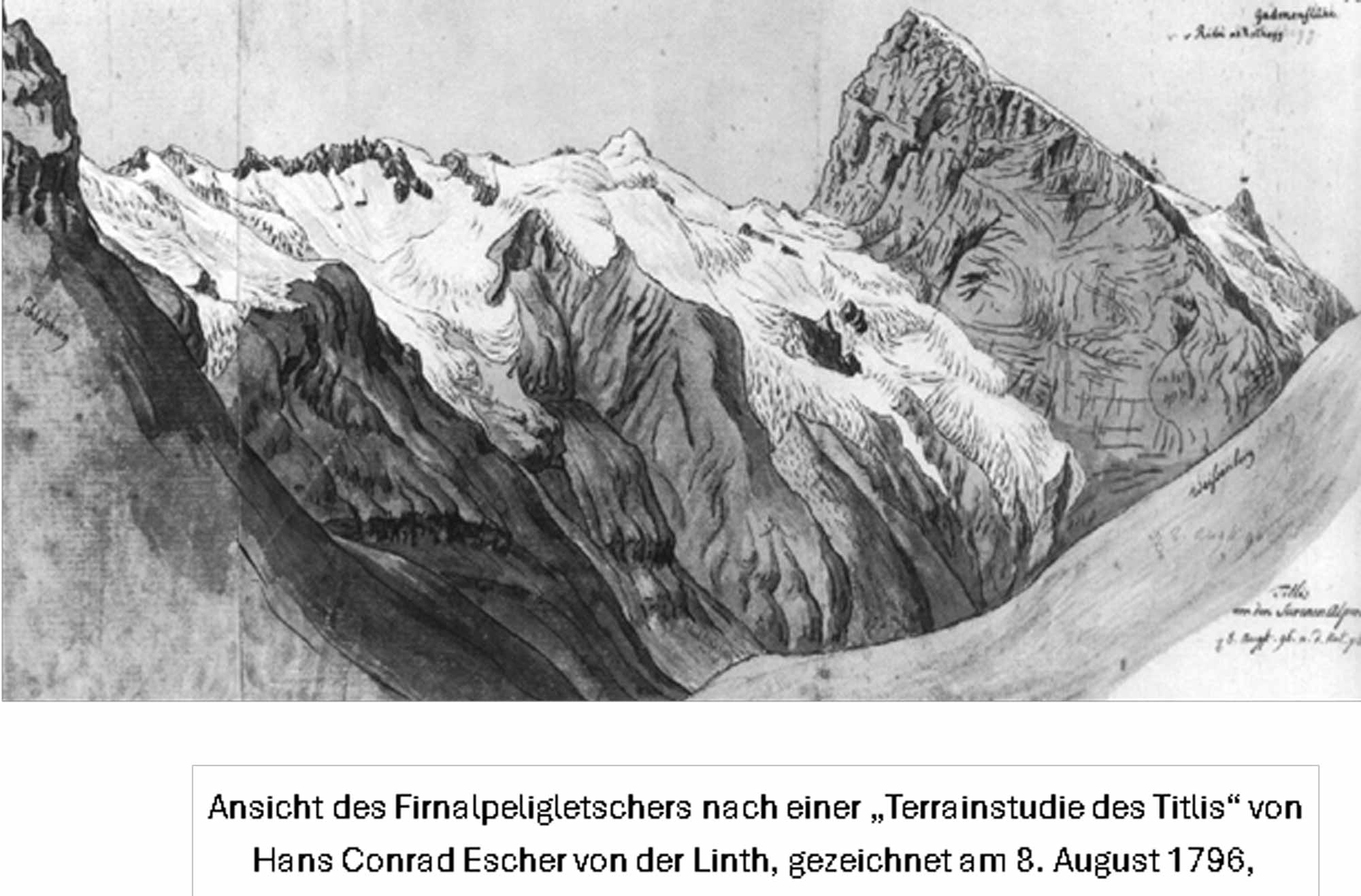
4 Glacier world 1796 and today
From eternal ice to meltwater: The firnalpeli glacier is an example of glacial retreat
The Grotzli Walk offers breathtaking views of the glacier world on the opposite side of the valley.
Glaciers still crown the ridges between Titlis and Spannort. Their deepest zones are called accumulation areas, where layers of snow gradually compact into firn and eventually transform into glacier ice.
Today, however, the glaciers are in continuous retreat. A clear example is the Firnalpeli Glacier, which stretches down from the Grassen area. This glacier has been under surveillance since 1894.
Between 1894 and 1950, it retreated by 150 meters. Then, between 1950 and 1980, it advanced again by around 140 meters. Since then – especially in recent years – it has receded by approximately 400 meters.
Compared to a historical drawing from 1796, the glacier is barely recognizable today and may disappear entirely within the next few years.

5 Alpine legend of Surenen
We find ourselves close to the border with the canton Uri and enjoy a view up towards the Surenen Pass. The border between Engelberg and Uri has a colourful history - not least in the legend of the Uri bull.
A young shepherd on the Surenenalp loved one of his lambs so dearly that he wanted to baptize it like a human. He went over the Surenen to Attinghausen, taking a christening stone and christening water with him and baptised the lamb.
No sooner had he done so than a storm arose, and the lamb transformed into a terrible monster that destroyed the hut and the shepherd boy with it. The creature – known as the Greiss – would no longer tolerate humans or animals on Surenen. The people of Engelberg soon abandoned the alp and sold it cheaply to the people of Uri. But they fared no better.
A mysterious little dwarf gave them this advice: They should raise a silver-white bull calf for seven years, feeding it each year with the milk of one more cow than the year before. When the bull was strong enough, a virgin would have to lead it to the monster using her hair ribbons. At the scent of the Greiss, she should release the bull – and turn back without looking.
Everything happened as foretold – except the girl could not resist her curiosity. She turned around. A terrible roar rang out, and a column of smoke rose to the sky. The Greiss was dead – and the girl was never seen again. The bull also died, having drunk too greedily from the mountain stream after the heat of battle. The region was freed from the monster – but in the minds of the people of Uri, its shadow lingered.
Much later still, when livestock died in mysterious ways, they would blame the Greiss. And the stream from which the bull drank still bears the name Stierenbach (“Bull Stream”) to this day.
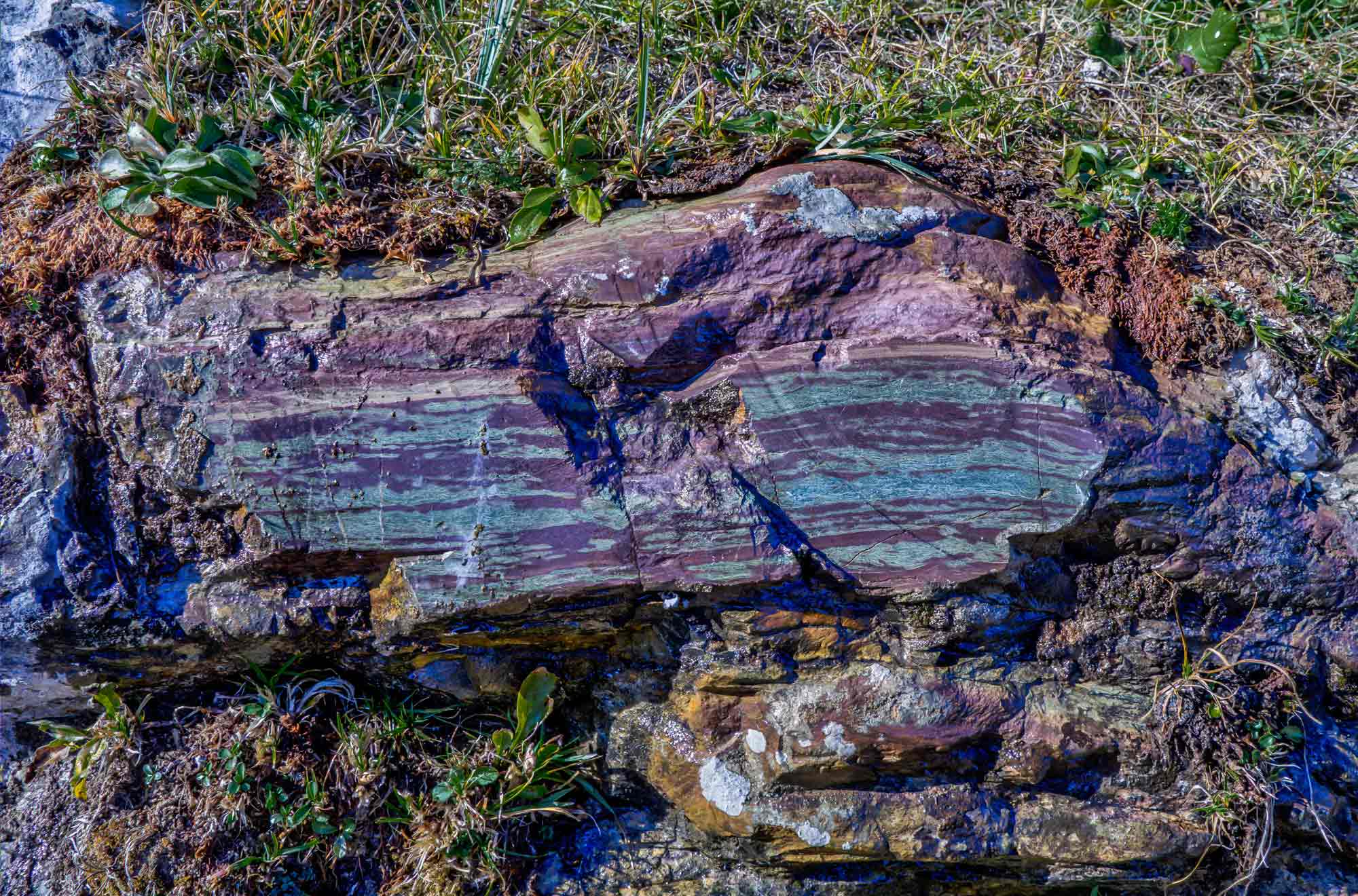
6 Fürenalp marble
A glimpse into rare rock formations
Along this section of the trail, we are walking on a truly fascinating type of rock. Its appearance is irregular: it mainly consists of white-grey limestone fragments, often tinted yellowish or greenish, in a mixed and chaotic structure. Between these fragments lie iron-rich, rust-colored weathered red and green shales or sandstones. This rare rock, which we call “Fürenalp Marble,” occurs only in a few isolated places along the northern edge of the Alps. It is a siderolithic breccia (sideros = iron, lithos = stone, breccia = rock composed of angular fragments).
Geologically speaking, it is a consolidated karst infill formed from weathered debris — created around 50 million years ago.
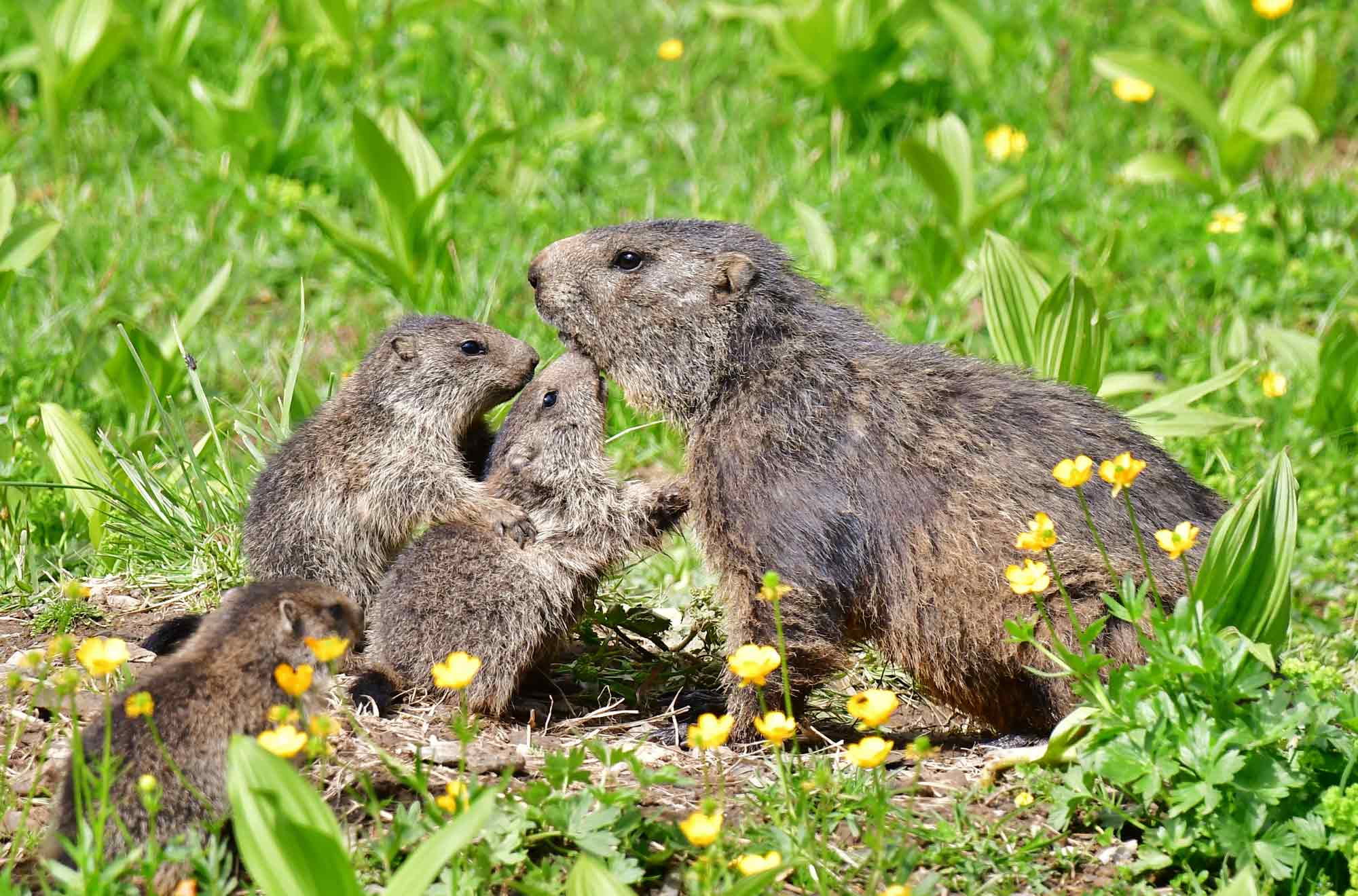
7 wildlife paradise
From marmots to golden eagles: Encounters with alpine wildlife
Thanks to its sunny location, varied habitats, and proximity to the Hahnen wildlife reserve, Fürenalp is home to a rich diversity and abundance of wild animals.Chamois, roe deer and red deer can often be seen on the rocky slopes and alpine meadows around Wissberg and Fürenhochflue. In their search for food and shelter, these animals migrate across the Fürenalp from Tagenstall toward the Surenen Pass. Grouse and other forest birds also inhabit the shrubs and small woodland patches.
With a bit of luck, you may spot marmot burrows along the trail – and perhaps even see a marmot pop out. On warm summer days, they like to come out to bask in the sun. One older animal usually keeps watch from a high point, giving a sharp whistle to warn the colony of danger. Marmots’ natural predators include the majestic golden eagle. Other animals spotted here include buzzards, red kites, hawks, foxes, badgers, lynx – and the striking wheatear, a bird that migrates every year from the Sahara Desert to breed here, often seen perched on boulders.
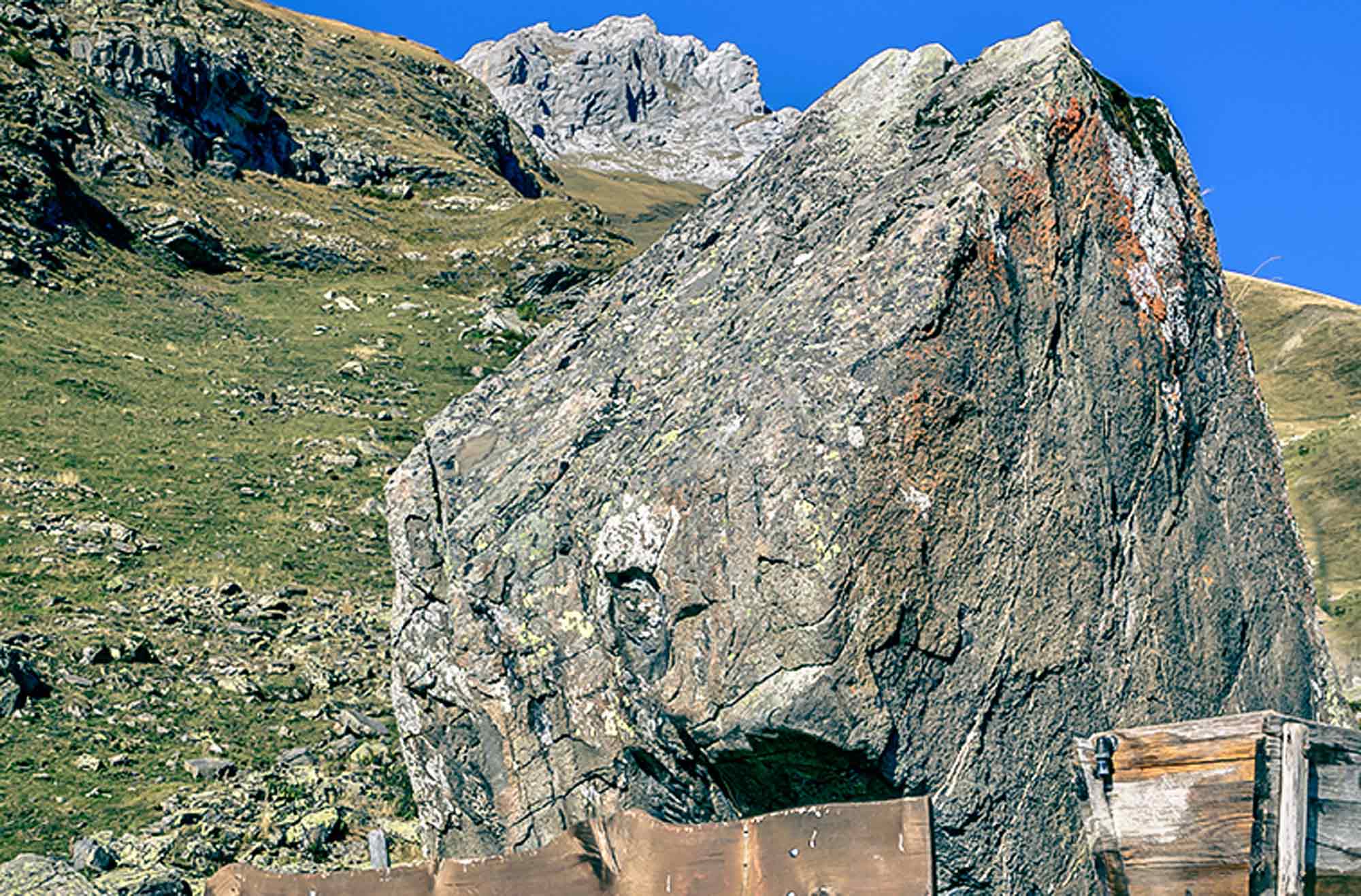
8 Gummstein and its inhabitant
The imposing angular boulder, which the locals call Gummstein, is made of very rough, dark and compact sandstone. When one looks very closely, one sees that the surface is covered with a wide variety of lichen- especially in the areas where it stays moist. The yellow Rhizocarpon Ramond and the bright orange “goldkrusten” lichen are the first to be noticed.
Lichens are composite organisms consisting of a symbiotic association of a fungus (the mycobiont) with a photosynthetic partner. Thanks to the fungus, the lichen is able to photosynthesise, using light to make organic material.
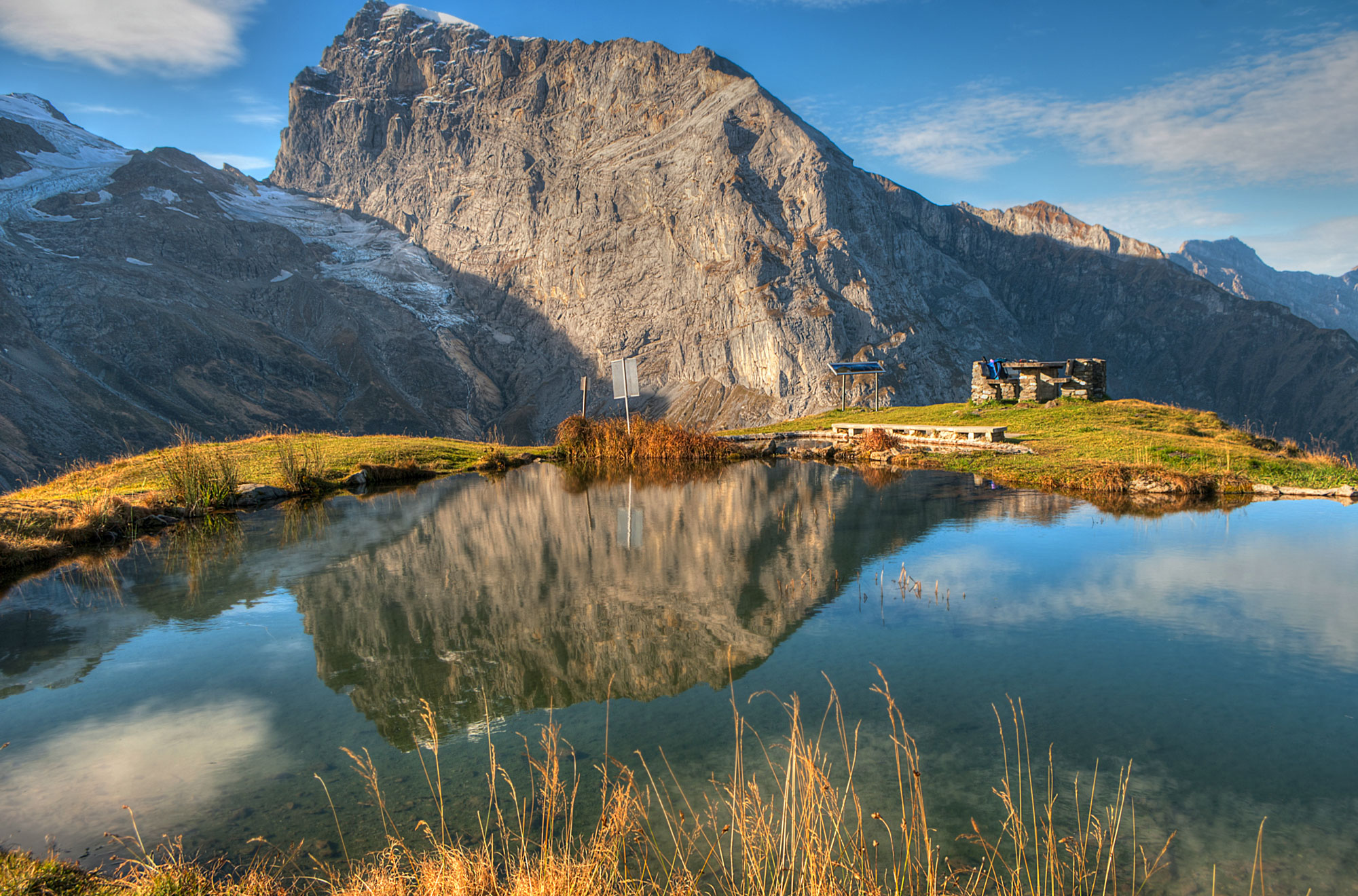
9 Habitat of the Spiegelseeli
The Spiegelseeli (Mirroring Lake) is not only a popular photo spot but also teeming with life. You might spot tadpoles and frogs swimming in its shallow waters. One of the lake’s most fascinating residents is a dragon-like creature: the alpine newt, also known as Ichthyosaura alpestris. It measures around 8 to 12 centimeters in length and can be recognized by it colorful belly - a vivid yellow-orange to reddish with no spots.
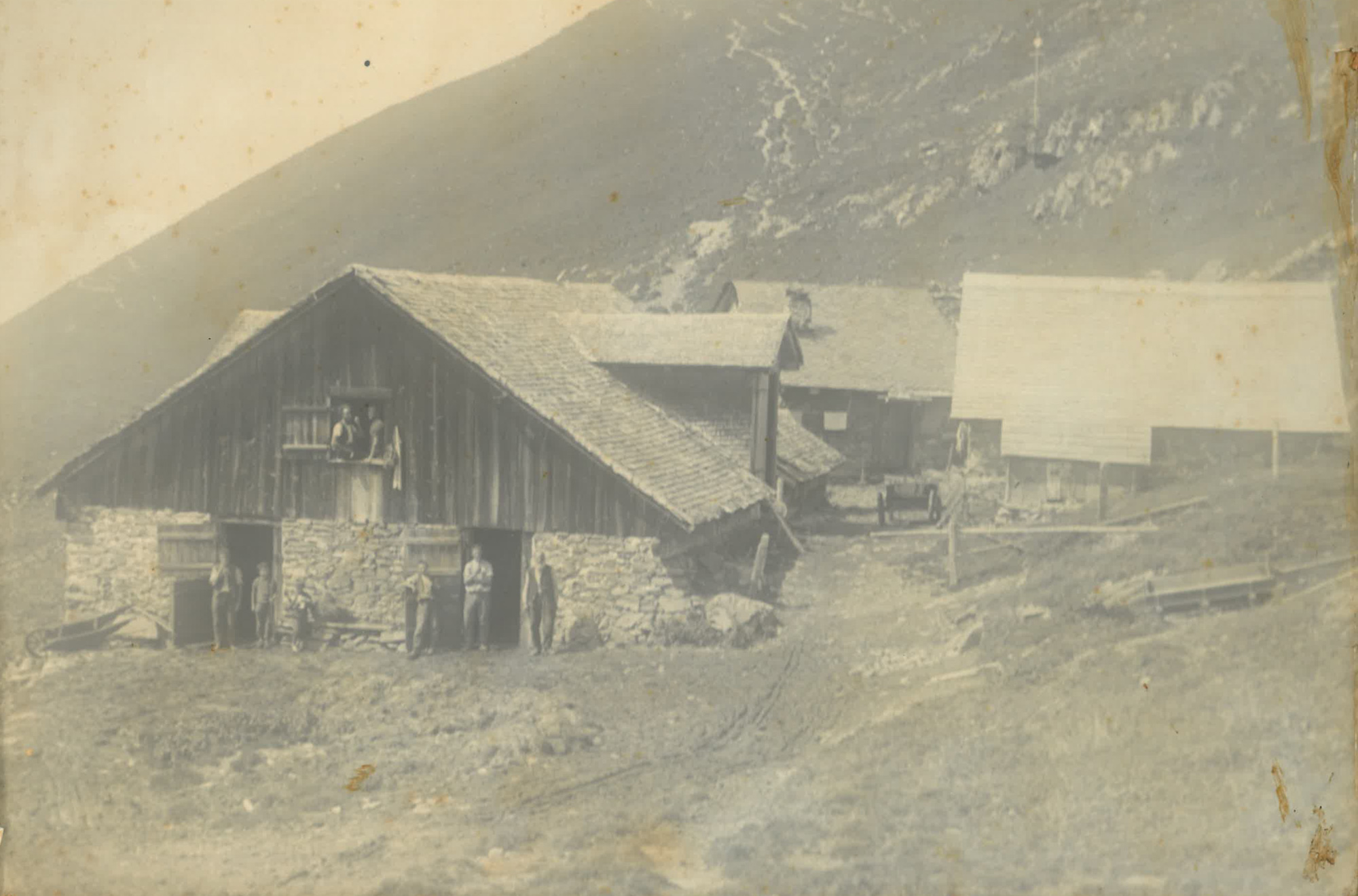
10 Alp Hinter Füren
From noblemen to family farm: The history of Fürenalp
Like the entire Engelberg Valley, Fürenalp was originally under the control of the noble family of Seldenbüren around the year 1100. In 1122, the whole Engelberg region was handed over to the Benedictine monastery. According to historical sources, the Alp Füren — along with areas like Kilchbühl, Vorderhorbis, Zieblen, and Rohr — was sold by the monastery around 1763, following a devastating flood in 1762, which had caused serious financial hardship for the abbey. Over the years, the alp changed hands several times, often briefly owned by well-known Engelberg families such as Hess and Waser. The Matter family has owned Alp Hinter Füren since October 25, 1869. Together with an alpine herdsman, the alp is actively farmed for three months each year — from mid-June to mid-September.
The buildings on the alp have been destroyed by violent storms more than once. The oldest remains of early alpine construction is a foundation stone engraved with the year 1667. The roof of the hut was once covered with slate from a quarry located about 300 metres away, near Tagenstall. Until around 1930, the two alps — Vorder and Hinter Füren — were physically connected by their buildings, which also explains the unusual boundary line running directly next to the current hut.
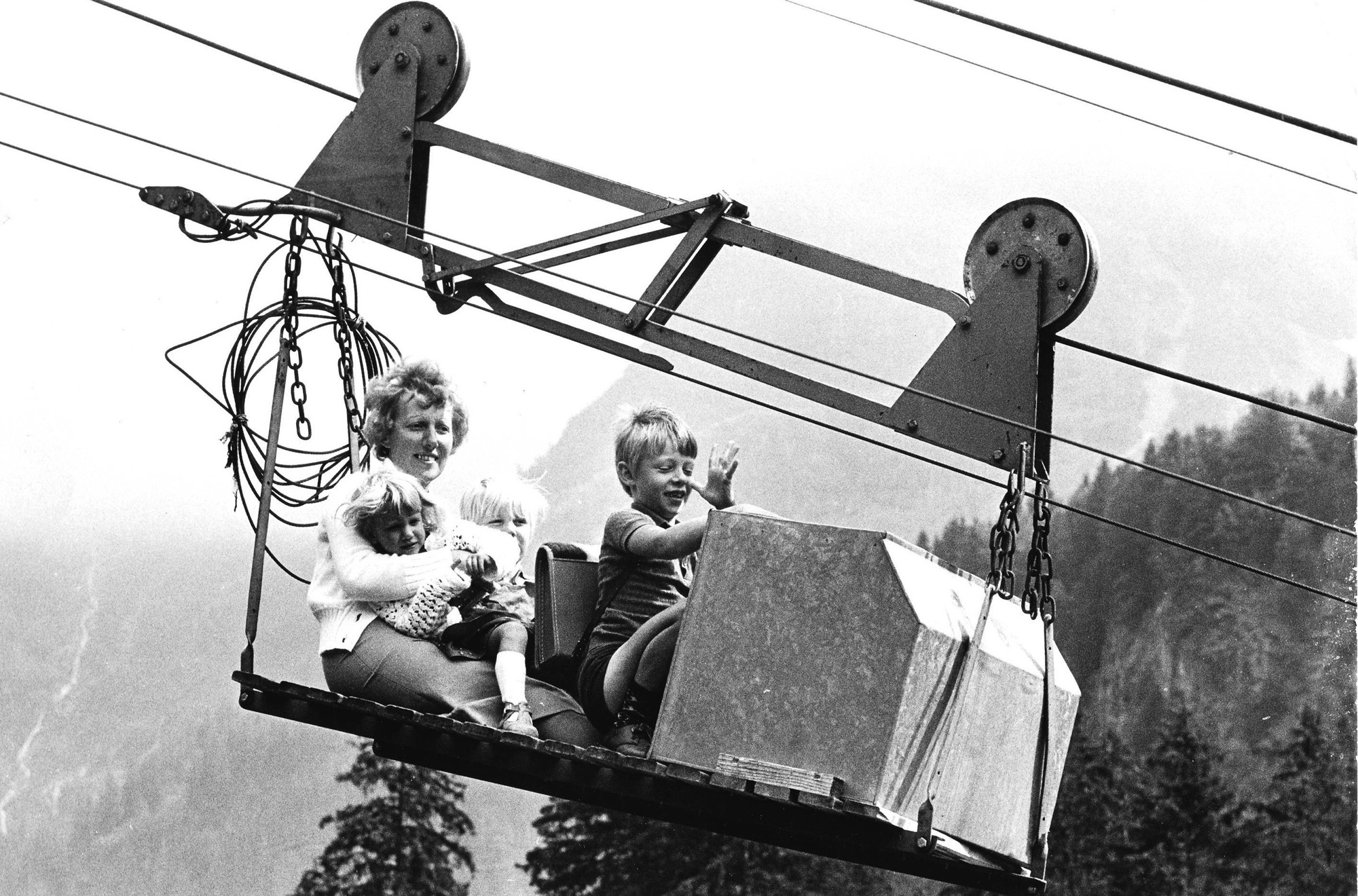
11 The Development of the Fürenalp Cable Car
From water-powered transport to a modern aerial cableway
The first transport cableway from Herrenrüti to Fürenalp was built in 1906. In 1925, this system was converted into a water-powered funicular with two sections: Herrenrüti–Hohmatt and Hohmatt–Füren. This was a highly eco-friendly and cost-effective system that operated using gravity-driven water tanks and manual power. A water container at the top station was filled, creating a counterweight to the “barelle” carriage in the valley, allowing it to descend. For passenger safety, a manual emergency brake was installed on the carriage’s running gear. The main brake system was wooden blocks acting directly on the pulley wheel.
The current modern aerial cable car was installed in 1979. It carries eight passengers and overcomes a height difference of 761 metres. Today, guests can enjoy a scenic ride with stunning views of the Engelberg monastery village and surrounding alpine peaks. Shortly after the new cableway was completed, the mountain restaurant Fürenalp was built, featuring a unique panoramic terrace. Inspired by the majestic mountains and using regional ingredients, it offers Swiss classics alongside creative seasonal dishes. The wine list is selected with passion, and sweet dreams come true with homemade cakes and fine desserts. Come and treat yourself!
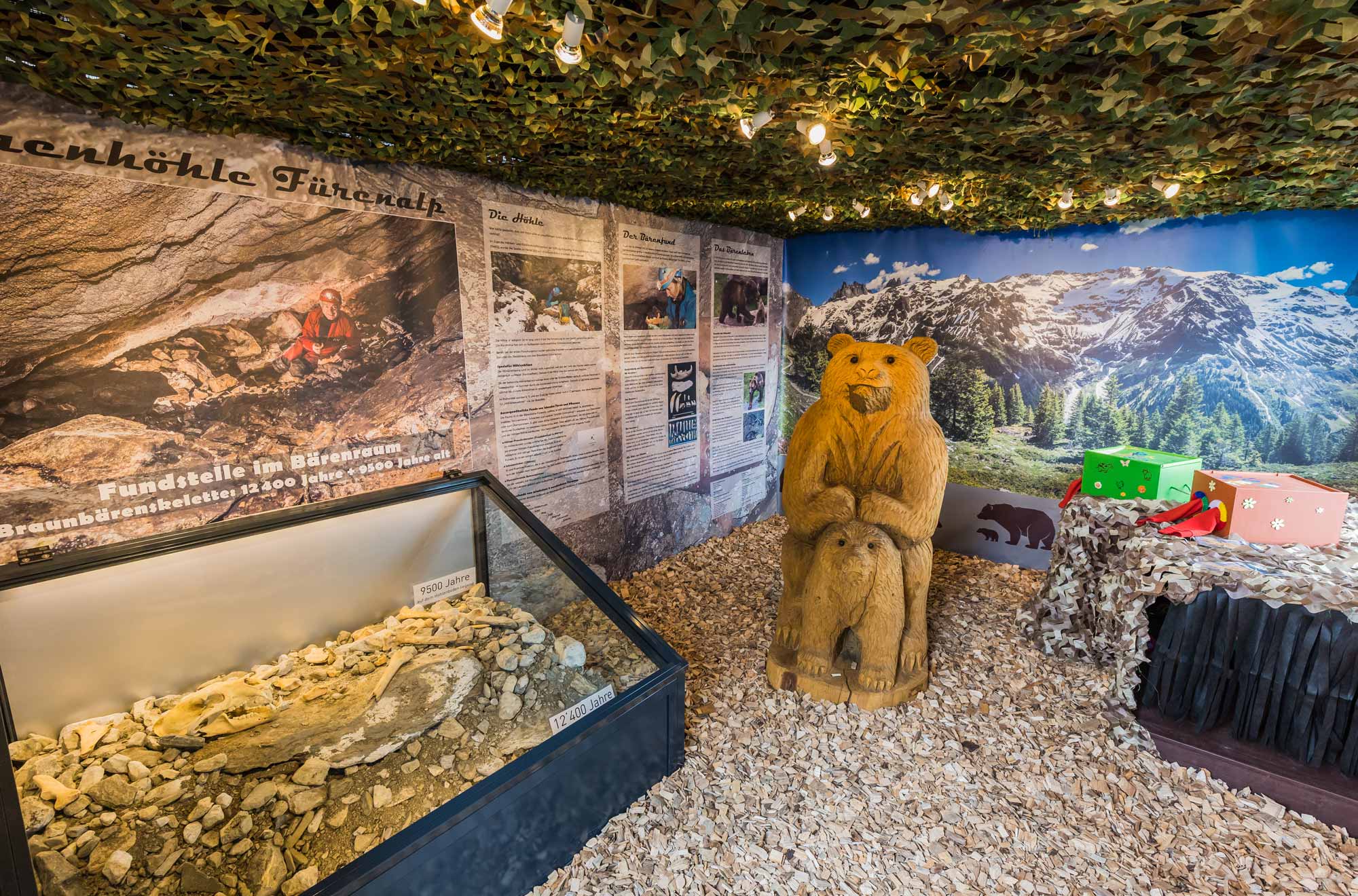
Exhibition "Bear`s Nest"
Who would have thought it? Behind such an inconspicuous crack in the rock lies a cave with such spectacular findings! How old could this bear be? Excavation with surprises - two of them lived on the Fürenalp 9500 and 12400 years ago. In particular, the oldest post-glacial brown bear found in Central Switzerland. The small but nice exhibition "Bear's Nest" gives an insight into the unique history of discovery and the life of a bear.


